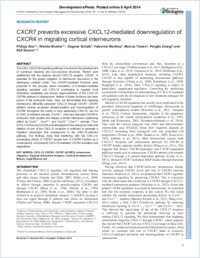CXCR7 prevents excessive CXCL12-mediated downregulation of CXCR4 in migrating cortical interneurons
- Abe, Philipp Institute of Pharmacology and Toxicology, Jena University Hospital, Friedrich Schiller University Jena, Jena 07747, Germany
- Mueller, Wiebke Institute of Pharmacology and Toxicology, Jena University Hospital, Friedrich Schiller University Jena, Jena 07747, Germany
- Schütz, Dagmar Institute of Pharmacology and Toxicology, Jena University Hospital, Friedrich Schiller University Jena, Jena 07747, Germany
- MacKay, Fabienne Department of Immunology, Monash University, Alfred Medical Research and Education Precinct (AMREP), 89 Commercial Road, Melbourne, Vic 3004, Australia
- Thelen, Marcus Institute for Research in Biomedicine (IRB), Faculty of Biomedical Sciences, Università della Svizzera italiana, Switzerland
- Zhang, Penglie ChemoCentryx, 850 Maude Avenue, Mountain View, CA 94043, USA
- Stumm, Ralf Institute of Pharmacology and Toxicology, Jena University Hospital, Friedrich Schiller University Jena, Jena 07747, Germany
-
09.04.2014
Published in:
- Development. - 2014, vol. 141, no. 9, p. 1857-1863
CXCL12
CXCR4
CXCR7 (ACKR3)
Interneuron migration
Atypical chemokine receptor
Cortical development
Mouse
Cajal-Retzius cell
English
The CXCL12/CXCR4 signaling pathway is involved in the development of numerous neuronal and non-neuronal structures. Recent work established that the atypical second CXCL12 receptor, CXCR7, is essential for the proper migration of interneuron precursors in the developing cerebral cortex. Two CXCR7-mediated functions were proposed in this process: direct modulation of β-arrestin-mediated signaling cascades and CXCL12 scavenging to regulate local chemokine availability and ensure responsiveness of the CXCL12/CXCR4 pathway in interneurons. Neither of these functions has been proven in the embryonic brain. Here, we demonstrate that migrating interneurons efficiently sequester CXCL12 through CXCR7. CXCR7 ablation causes excessive phosphorylation and downregulation of CXCR4 throughout the cortex in mice expressing CXCL12, but not in CXCL12-deficient animals. Cxcl12−/− mice lack activated CXCR4 in embryonic brain lysates and display a similar interneuron positioning defect as Cxcr4−/−, Cxcr7−/− and Cxcl12−/−;Cxcr7−/− animals. Thus, CXCL12 is the only CXCR4-activating ligand in the embryonic brain and deletion of one of the CXCL12 receptors is sufficient to generate a migration phenotype that corresponds to the CXCL12-deficient pathway. Our findings imply that interfering with the CXCL12-scavenging activity of CXCR7 causes loss of CXCR4 function as a consequence of excessive CXCL12-mediated CXCR4 activation and degradation.
- Language
-
- English
- Classification
- Medicine
- License
-
Rights reserved
- Open access status
- hybrid
- Identifiers
-
- RERO DOC 324250
- DOI 10.1242/dev.104224
- ARK ark:/12658/srd1318866
- Persistent URL
- https://n2t.net/ark:/12658/srd1318866
Statistics
Document views: 213
File downloads:
- Texte intégral: 249
